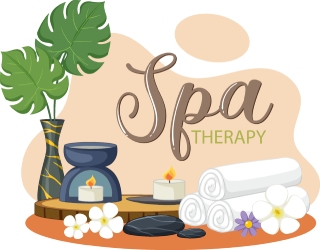Going to a spa in Canada is a moment to relax and unwind, but to experience it fully, understanding the norms and etiquettes of a particular spa is important. It might vary by region or location, yet most have etiquette regarding behavior and cleanliness; a good space for sharing. To mean a new person or someone who frequently visits a spa, those underlying rules should be taken into account for everyone’s comfort.
Booking and Arrival Expectations

You haven’t even stepped in the door for your spa appointment in Canada – it often starts before that. Getting advance bookings is recommended, especially in high-demand urban or resort town areas. Typically, one can book by secure online system or old-fashioned telephone call, followed by a way that the company will usually confirm with an email or call or however it is that it is set up.
Getting there on time is important: most spas ask you to arrive 15 to 30 minutes early, especially for first-timers, to check in, fill out any necessary forms, and start relaxing before your treatment. Showing up late might affect the effectiveness and refund policy, as most therapists follow fixed schedules.
Dress Codes and Changing Areas
When it comes to dress codes at Canadian spas, the general guideline is modesty and personal comfort. Usually, they provide a robe, slippers, and sometimes disposable undergarments if needed. It is customary to disrobe to the level you feel comfortable with. Full nudity is common for massages and body treatments, but modern standards of modesty require guests to wear something between the skin and the sheet, towel, or service being provided. At no point should anyone be fully exposed, as professional draping is strictly followed.
Spacious changing rooms feature lockers for your belongings, and the sign “nudity expected only in designated areas” appears next to italics sentences that indicate it is OK to be nude in the shower or treatment room. Usually, in mixed-gender areas like pools or saunas, people wear swimsuits unless a sign states otherwise. If you do not understand what you see on the sign, always ask a staff member.
Quiet Zones and Shared Spaces
Canadian spas definitely prioritize maintaining a peaceful environment. Usually, you only hear soft, whisper-like words in the relaxing lounge, sauna, and treatment areas. In this context, mobile phones are mostly discouraged or sometimes banned to support a specific spa culture.
If you use common facilities like a whirlpool, wet sauna, or hydrotherapy pool, take a quick shower and avoid outbursts that could disturb others. If all spots are full, wait for your turn or ask the staff for help. People really value their quiet while napping in public, so don’t reserve lounge chairs with belongings for hours.
Communicating with Therapists
This kind of positive communication is not only allowed but also encouraged in a spa setting in Canada, as long as it remains respectful and appropriate. Usually, your therapist will discuss any medical conditions, preferences, or sensitivities as part of the pre-treatment process. If you like certain pressure levels, have injuries, or want a specific area skipped during the massage, now is the time to mention it.
In the middle of the treatment, you are set to alert when you feel uncomfortable or there is a kind of change you want to see. Therapists are professionals and they do respond to such issues devoid of any form of judgment. Still, chatting eats into the time the therapist would otherwise spend on services unless he starts the light conversation. Silence is important in most cases of relaxation.
Hygiene and Personal Responsibility
The practice of cleanliness is a two-way thing. The customers should arrive neat in their own skin, especially when using water-based facilities. Some bathrooms even require a shower before getting wet in the communal pool or sauna. Stay clear of putting on lotions, perfume, or other greasy substances that could somehow spread through all of your surfaces.
They also maintain cleanliness through regular, thorough cleaning and sanitation of the spa. Usually, towels, robes, and slippers are washed after each guest use. If there is anything that seems unsanitary or unclean, please inform the staff in a clear manner. It’s a shared responsibility to ensure a clean and comfortable environment.
Tipping and Payment Etiquette
Tipping is common in Canadian spas, though policies may vary slightly by province or spa. Typical gratuity rates range from 15% to 20%, similar to those in restaurants. Some spas include gratuity in the total bill, especially in resort settings, so make sure to check your receipt.
Tips are usually given directly to the therapist or can be added when settling the bill. If you’re unsure about what’s appropriate, you can always ask the front desk staff, who are generally helpful. Giving a generous gratuity is a good way to say “thank you” without expecting anything in return.
Regional and Cultural Variations

When visiting a spa, their behaviors tend to be quite similar regardless of where you are in Canada. However, regional differences can be observed. For example, in Quebec, European influences are quite distinct. As a result, many well-known Nordic spas enforce strict non-speaking policies, and there are various areas where patrons can choose to be naked or not. British Columbia is renowned for its eco-designed spas, and one way they promote sustainability is by limiting the use of water resources, such as encouraging guests to bring their own water bottles so they do not need to request water.
Canada’s cultural diversity means everyday customer service staff, but for their types of clients, they have to learn how to handle all the possible scenarios visitors might request. Therefore, guests must share their specific religious and cultural needs, such as requesting a same-gender therapist at the time of booking, and in most cases, services are discreetly adjusted unless guests specify they want them to be more noticeable.
Cancellation and Rescheduling Norms
Typically, a Canadian spa has a cancellation policy that does not exceed 24-48 hours. If, however, the appointment is canceled later (or even not attended), a fee of 100% of the service charges will be applied. These policies are designed to protect staff scheduled times and operational costs.
If you need to reschedule, do so as soon as possible. Most spas generally accept emergencies if you give them proper notice. When trying to switch your appointment, be sure to send a courteous and clear call or email. Avoid frequent last-minute cancellations, as these can lead to a high-risk status.
Wellness Overindulgence
Many Canadians consider public bathhouses to be luxurious amenities in Canada. However, most view them as part of a comprehensive wellness program. Sometimes, medical insurance covers services like massage therapy, physiotherapy, or hydrotherapy if they are medically recommended. As a result, visits to spas are not solely for recreation; often, they serve functional, health-focused purposes.
Summary
Spa etiquette in Canada combines professionalism with a few personal touches, all aimed at making everyone comfortable. It begins with punctuality and dressing appropriately, extending to quiet areas… for very simple and precise reasons. Following these best practices creates a pleasant environment for all.
Whether you’re in the countryside with all its spots or at a trendy, upscale wellness center, it’s simple: be mindful, stay humble, and enjoy being perfectly fine.

